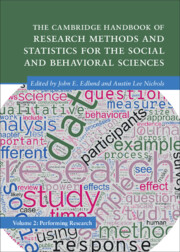 The Cambridge Handbook of Research Methods and Statistics for the Social and Behavioral Sciences
The Cambridge Handbook of Research Methods and Statistics for the Social and Behavioral Sciences Book contents
- The Cambridge Handbook of Research Methods and Statistics for the Social and Behavioral Sciences
- Cambridge Handbooks in Psychology
- The Cambridge Handbook of Research Methods and Statistics for the Social and Behavioral Sciences
- Copyright page
- Dedication
- Contents
- Figures
- Tables
- Contributors
- Preface
- Part I Quantitative Data Collection Sources
- Part II Important Methodological Considerations
- Part III Self-Report Measures
- Part IV Behavioral Measures
- Part V Physiological Measures
- Part VI Qualitative Data Collection Sources
- 24 Open-Ended Survey Questions
- 25 Qualitative Archival Data: A Call to Creativity
- 26 Interviews: Processes, Strategies, and Reflections
- 27 Case Studies: A Personal Account of Choices and Dilemmas
- 28 Focus Groups
- 29 Observational Data
- Index
- References
25 - Qualitative Archival Data: A Call to Creativity
from Part VI - Qualitative Data Collection Sources
Published online by Cambridge University Press: 12 December 2024
- The Cambridge Handbook of Research Methods and Statistics for the Social and Behavioral Sciences
- Cambridge Handbooks in Psychology
- The Cambridge Handbook of Research Methods and Statistics for the Social and Behavioral Sciences
- Copyright page
- Dedication
- Contents
- Figures
- Tables
- Contributors
- Preface
- Part I Quantitative Data Collection Sources
- Part II Important Methodological Considerations
- Part III Self-Report Measures
- Part IV Behavioral Measures
- Part V Physiological Measures
- Part VI Qualitative Data Collection Sources
- 24 Open-Ended Survey Questions
- 25 Qualitative Archival Data: A Call to Creativity
- 26 Interviews: Processes, Strategies, and Reflections
- 27 Case Studies: A Personal Account of Choices and Dilemmas
- 28 Focus Groups
- 29 Observational Data
- Index
- References
Summary
Not all empirical investigations require fresh data collection. Abundant sources of data, amenable for systematic evaluation, already exist in the form of archival data. Meaning may be extracted from a variety of data sources surrounding us (primary archival data – e.g., obituaries, blogs, yearbooks) or from data previously collected by other researchers (secondary archival data – e.g., computerized archives). Examples of both primary and secondary archival data are provided, with an emphasis on qualitative sources. Common techniques for analyzing qualitative data are then described, and a suggested set of steps for proceeding with a study employing archival data is detailed. The chapter ends with a list of important qualitative secondary archival data sets.
- Type
- Chapter
- Information
- The Cambridge Handbook of Research Methods and Statistics for the Social and Behavioral SciencesVolume 2: Performing Research, pp. 571 - 590Publisher: Cambridge University PressPrint publication year: 2024
